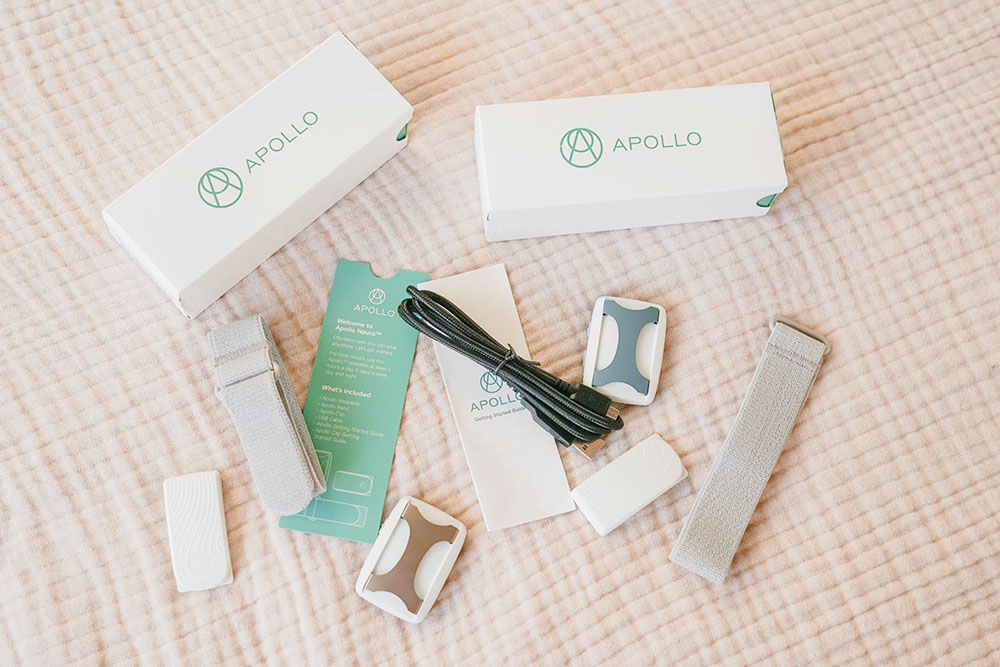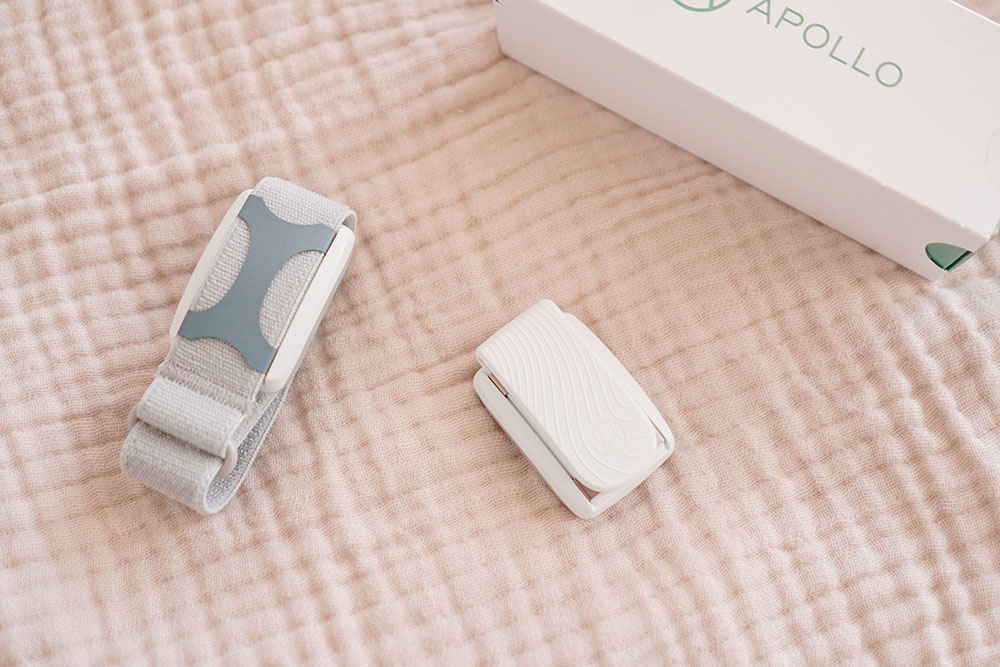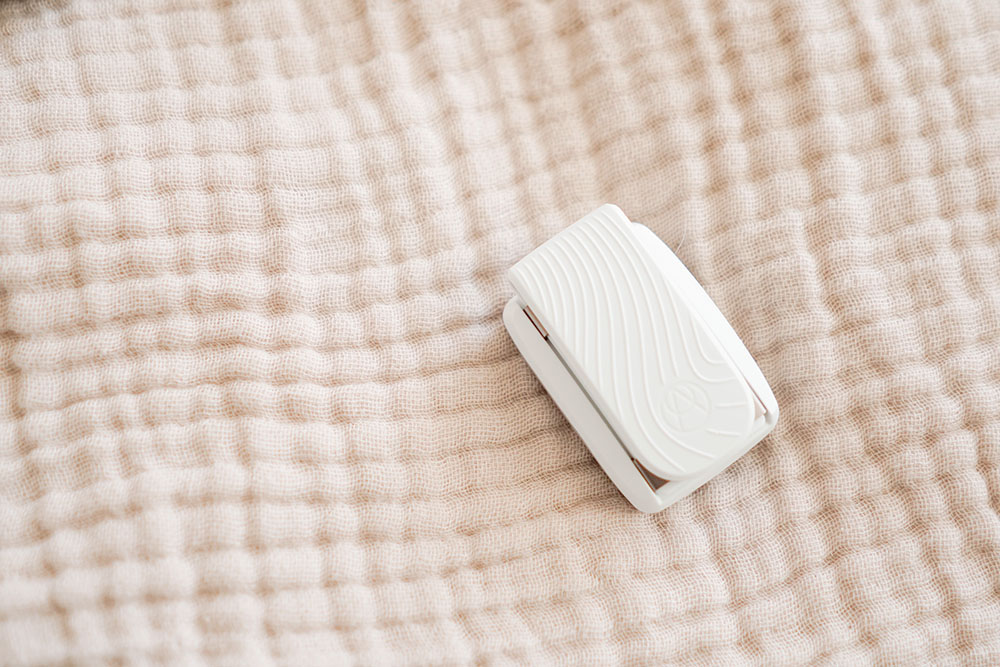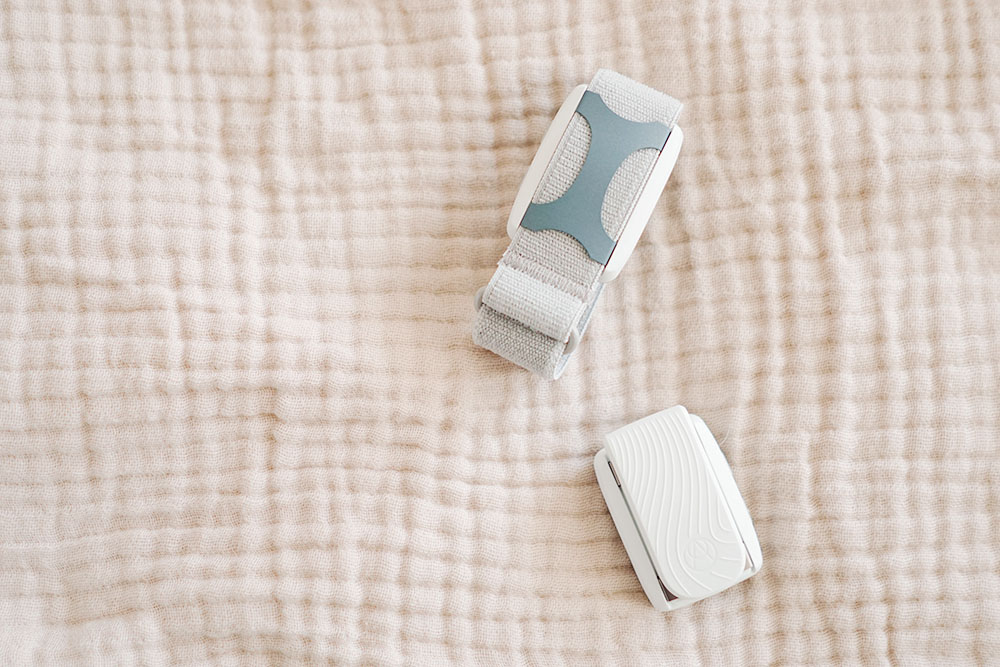
For lovers of wearables, there’s a new(er) device on the market. The Apollo stress reliever and sleep aid wearable is designed to help you manage your sleep, focus, heart rate variability, and more. How does it work? Does it do all it claims to? Should you buy it? Let’s find out.
What’s in the box of the Apollo?
In the box of the Apollo, you’ll find the device itself along with a matching velcro wristband and clip. It comes with a quick start guide as well as a micro-USB charging cable. There is currently only one size of the Apollo available, which the brand refers to as their Medium, and there is no option to charge it using a more common cable type.
The Apollo wearable is available at Best Buy in two colours: Glacier and Slate. Both are featured in this review. Glacier has a grey accent on its wristband while Slate has a contrasting dark blue accent. The wrist bands and form factors of both of these colourways are identical.

What is the Apollo wearable?
The Apollo exists in a product category that I haven’t really delved into before. In a sea of fitness wearables, this is a wearable that’s designed to help you manage your stress and recovery time through what the brand calls ‘touch therapy’. It uses an array of vibrations to calm, focus, and energize you throughout your day.
Apollo has designed seven different vibration patterns to these ends, referred to as Apollo Vibes. They are Calm, Unwind, Energy, Focus, Recover, Social, and Fall Asleep. The product is primarily designed to help users manage their stress for overall lower cortisol levels, but the brand also cites studies suggesting that it can help increase HRV (heart rate variability), increase focus during the day, and both deepen and lengthen your sleep cycle.

How to use the Apollo
To use the Apollo, the brand recommends wearing it against your skin using the included clip or wristband. The wristband can be used on both wrists and ankles; the clip can place the product on any item of clothing that will hold it against your skin. (For instance, your waistband, collar, or bra strap.) You can face the Neuro on the inside or outside of your wrists and ankles.
From there, you set the Apollo’s duration and intensity using the Apollo Neuro app. The brand recommends starting out with a 15 – 60 minute session at 20% – 40% intensity. Ideally, they suggest that you should forget that you’re wearing the product at all—it should exist in the periphery of your conscious mind, if anything.
(This reminds me, perhaps ironically, of setting the colours and contrast of a tense, dark video game: “decrease this slider until you can barely see the logo above.” Perhaps this is the inverse of that, placing an intensity just on the fringes of sensation—but this time to calm instead of to thrill.)
This product is recommended to be used for at least three hours a day, five days a week. It is not waterproof (though it is splash-resistant) and takes up to 4 hours to charge. There are two physical buttons on the Apollo, which can be used to increase or decrease the intensity of your current Vibe pattern, restart the last vibration played, or pause/play your current vibration.
Is the science solid?
This wearable is backed by a number of studies that suggest that the Apollo could be an effective tool in managing stress and increasing HRV. However, something that I think is important to note is that very little of this research involved double-blind, placebo-controlled studies, which is the most reliable type of data to collect to determine a product’s (that is, an experimental variable’s) efficacy. The Apollo brand is very proud to advertise that their product is backed by two such studies, but when you look into them, you’ll find that one “has a similar statistical power … as a total sample size of approximately 106 participants” while in reality having only 22 participants. The other is a study with “the equivalent of 212 subjects,” also known as 38 subjects. (Source.)
What I take this to mean is that the science may be there. However, as a consumer, it isn’t yet well-supported enough to meet my personal standards. This may or may not matter to you, and will differ in importance for everyone. I would argue that you’ll encounter similar evidentiary weaknesses in many, if not most, wearable products on the market right now.
Instead, for a product like this, I generally rely on reviews and goals. The science may not suggest that these vibrations will improve your stress levels, but we know from other studies that a) placebo effects are genuinely, reliably effective and b) having something to focus on, like a vibration, can effectively reduce stress and over-stimulation. If you’re interested in the science behind this product, I would recommend doing your own research on the Apollo. However, I’d also recommend reading up on studies about fidget toys, vibration therapy, and specifically vibration toys for autism and ADHD, which is how I personally look at the Apollo.

How I view the Apollo
This may sound strange to say, but I approach the Apollo as a very expensive vibration toy (not the personal pleasure kind). In my opinion, that’s what it fundamentally is. This is a device that exists to help you focus on your body sensations and responses through vibration, which in turn can help your body naturally regulate how it feels and functions. It feels satisfying to hold and is lightweight enough that it can be worn on most items of clothing as long as they sit tightly against your skin. At this price point, I would have liked to see a higher-quality wristband included with the device, but the device itself is sleekly designed out of lightweight, matte plastic.
The Apollo is easy to hook up to the Apollo Neuro app and is very simple to use. It functions exactly as described, has reliable Bluetooth connectivity, and runs near-silently. (This is another win for those hoping to use it as a vibration device—if you have sensory issues that stop you from using other vibration therapy toys, I think this one will be unlikely to set them off.)

What you can do in the Apollo Neuro app
In the app, you can set your Vibe, customize its intensity and duration, and create a schedule of Vibes for your day or week. The app logs how long you’ve used the Apollo for and tracks your “Apollo Benefits Score” to help you get the most out of the product. You also have the option to subscribe to the Apollo SmartVibes program in the app, which is a membership that’s currently priced at $129.99/year (as of January 12th, 2024) and adds in SmartVibes for Sleep, stress relief, and waking up. The Apollo app syncs with other services such as Apple Health and the Oura Ring.
I’ve reviewed many other wearable devices, including ones targeting similar functions to the Apollo such as sleep and heart rate variability. With most devices, an additional subscription gives you access to what is essentially “bonus content”—things like meditation audios and workout routines. This is the first device I can remember trying that requires an additional subscription to unlock its full feature array, and for that reason, I don’t think I would recommend the Apollo as a gift. It’s an interesting device, but I wouldn’t want my recipient to feel like they had to put money into their own gift in order to get the most out of it.
Unlike other app-controlled vibrating products that I’ve reviewed, I also noticed that Apollo doesn’t give you the option to customize your vibration patterns in the app. At this price point, I was disappointed to discover that. Users seeking a high level of fine-tuning and specificity will not, unfortunately, find it here.
My experience with the Apollo device and app
Overall, I didn’t really feel like the Apollo’s vibrations made a significant impact on my night or day, other than being slightly irritating. I find the wristband feels heavy and itchy, but because I tend to wear soft or loose clothing, it was my best option for continuous use. I also wash my hands a lot and it’s currently winter in Canada, so I didn’t really have a great option for where to place it: It’s not waterproof, so I didn’t feel like it was safe on my wrist during hand-washing. It also doesn’t fit underneath either boots or mittens, which are Canadian necessities.
I ended up having to move my device from my collar to my wrist a few times each day, which only added to my irritation—it’s not easy to swap from the clip to the wristband and back.
What puzzles me most about Apollo’s app and device integration is that the app samples the vibration experience for you using your phone during startup. It feels remarkably similar to that of the device, and as far as I can tell, the device itself hasn’t been designed to vibrate at any clinically-defined frequency. So, my question for the brand is… Why is there no option for users to just use their phones to experience the Apollo Vibes? Many wearable lovers already own arm bands for their phones, and if the Vibes are all primarily controlled in the app anyways, why can’t we play them off our phones, with the device as an additional option to enhance your experience and go phone-free? It would have been much easier to simply put my phone in my pocket versus moving a wearable device from one spot to another every few hours.

In conclusion
The Apollo is a unique foray into a wearable device that uses vibrations to optimize your daily life. It’s purported as a way to hack your stress, focus, and heart rate variability, among other things. I didn’t find it particularly effective for me, but your experience of the product could be very different from mine and, depending on your goals, you may get more out of it than I did.
The Apollo wearable is now available online at Best Buy.




